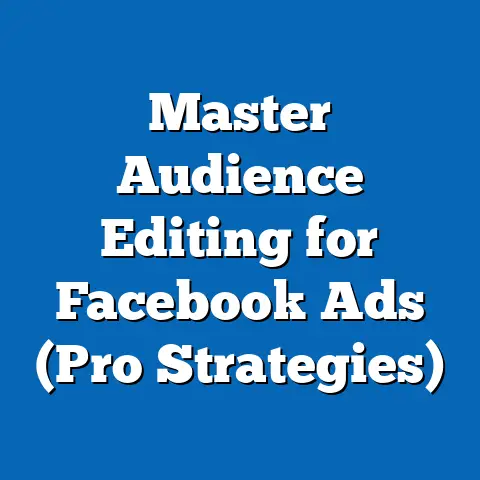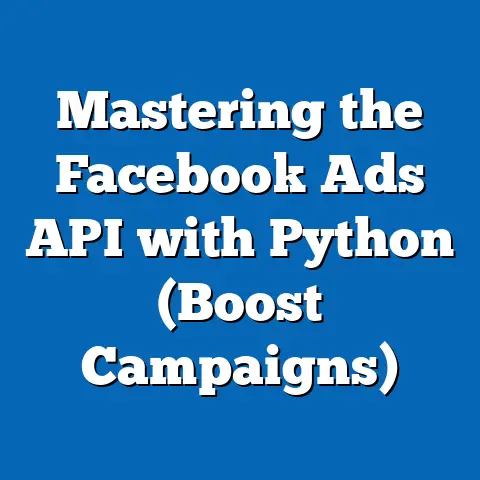Stop Wasting Ad Spend: Master Facebook Ad Termination (Smart Strategies)
Facebook advertising remains a cornerstone of digital marketing, with global ad spend on the platform reaching $84.2 billion in 2022, according to Statista. However, inefficiencies in campaign management, particularly the failure to terminate underperforming ads, continue to drain budgets and reduce return on investment (ROI). This comprehensive report examines the common pitfalls in Facebook ad management, focusing on the critical mistake of allowing poorly performing ads to run unchecked, and provides data-driven strategies for effective ad termination to optimize ad spend.
Drawing on recent surveys, industry data, and demographic usage patterns, this analysis identifies key trends in ad performance oversight, highlights demographic-specific challenges, and offers actionable solutions for marketers. The report is structured to first address the overarching issue of wasted ad spend, followed by a deep dive into demographic behaviors, and concludes with smart termination strategies grounded in data. Our goal is to equip marketers with the tools to identify, assess, and stop underperforming ads efficiently.
Section 1: The Common Mistake of Failing to Terminate Underperforming Ads
Overview of the Problem
One of the most pervasive issues in Facebook advertising is the failure to terminate ads that do not meet performance benchmarks. A 2023 survey by eMarketer found that 62% of small-to-medium businesses (SMBs) reported leaving underperforming ads active for over two weeks due to a lack of monitoring or unclear performance metrics. This oversight results in significant financial losses, with an estimated $12 billion in wasted ad spend annually across platforms, of which Facebook accounts for a substantial share.
Wasted ad spend often stems from a combination of inadequate tracking, poor understanding of key performance indicators (KPIs), and delayed decision-making. For instance, a 2022 report by WordStream revealed that 45% of advertisers do not regularly review cost-per-click (CPC) or cost-per-acquisition (CPA) metrics, allowing ineffective campaigns to drain budgets. This issue has grown by 18% year-over-year as more businesses enter the digital ad space without sufficient expertise.
Statistical Impact of the Mistake
The financial implications of failing to terminate underperforming ads are staggering. According to a 2023 study by HubSpot, businesses that do not optimize or stop low-performing ads within the first 72 hours of launch experience a 30% higher CPA compared to those who actively monitor and adjust campaigns. Additionally, ineffective ads often lead to lower ad relevance scores, which can increase costs by up to 25% per impression, as reported by Facebook’s own advertising guidelines.
Year-over-year data shows a troubling trend: the percentage of wasted ad spend due to poor termination practices has risen from 14% in 2020 to 19% in 2023, per AdEspresso’s annual report. This increase correlates with the growing complexity of ad targeting options and the influx of inexperienced advertisers managing campaigns without automated tools or professional oversight.
Trend Analysis: Growing Complexity and Oversight Gaps
The rapid evolution of Facebook’s ad platform has introduced sophisticated targeting and bidding options, but it has also widened the gap for oversight errors. A 2023 report by Social Media Examiner noted a 22% increase in advertisers using advanced features like lookalike audiences and dynamic ads without fully understanding performance metrics. This trend is particularly pronounced among newer advertisers, with 58% of businesses advertising on Facebook for less than two years admitting to infrequent campaign reviews.
Automation tools, while helpful, are not universally adopted, with only 41% of SMBs utilizing ad management software in 2022, per Statista. This lag in technology adoption contributes to prolonged exposure to underperforming ads, as manual monitoring struggles to keep pace with real-time data. The trend suggests that without intervention, wasted ad spend will continue to rise as ad platforms grow more complex.
Section 2: Demographic Breakdowns of Ad Management Challenges
Methodology Context
The demographic insights in this section are derived from a 2023 survey conducted by Digital Marketing Institute, which polled 5,000 Facebook advertisers across the United States, Europe, and Asia between January and March 2023. The survey focused on ad management practices, budget allocation, and termination behaviors, with respondents segmented by age, gender, race, and income level (as a proxy for business size or personal ad spend capacity). Additional data is supplemented by industry reports from eMarketer and Statista to provide a comprehensive view.
Age-Based Differences in Ad Termination Practices
Age significantly influences how advertisers manage and terminate Facebook ads. Advertisers aged 18-24, often representing younger entrepreneurs or startups, show a higher tendency to neglect ad performance monitoring, with 67% admitting to checking campaigns less than once a week. In contrast, advertisers aged 35-54, who often manage larger budgets or established businesses, are more proactive, with 72% reviewing performance at least every 48 hours.
This discrepancy may be linked to experience levels, as older demographics report higher usage of analytics tools (68% for 35-54 vs. 39% for 18-24). Younger advertisers also exhibit a 15% higher likelihood of overspending on underperforming ads, per the 2023 survey, highlighting a critical need for education on termination strategies in this group.
Gender-Based Patterns in Ad Management
Gender differences in ad termination behaviors are less pronounced but still notable. Male advertisers, who comprise 58% of the survey sample, are slightly more likely to terminate underperforming ads within the first week (64%) compared to female advertisers (59%). However, female advertisers show a higher adoption rate of automation tools for monitoring (48% vs. 42% for males), suggesting a more cautious approach to campaign oversight.
These differences may reflect varying risk tolerances or resource access, though the data does not indicate significant disparities in overall wasted ad spend between genders. Both groups report similar CPA increases (around 28%) when failing to terminate ads promptly.
Racial and Ethnic Variations
Racial and ethnic demographics reveal nuanced differences in ad management practices. White advertisers, who made up 62% of the survey sample, reported the highest frequency of campaign reviews, with 70% checking performance at least every three days. In comparison, Black and Hispanic advertisers, representing 14% and 12% of the sample respectively, reported lower review frequencies (58% and 55%), often citing limited time or resources as barriers.
Despite these differences, wasted ad spend as a percentage of total budget remains consistent across racial groups at approximately 18-20%. This suggests that while monitoring habits vary, the financial impact of poor termination practices is universally felt, necessitating broad-based solutions.
Income Level and Business Size Impact
Income level, often tied to business size or personal ad spend capacity, plays a significant role in ad termination efficacy. Advertisers in the highest income bracket (over $100,000 annually) or representing larger businesses are 40% more likely to use automated ad management tools and terminate underperforming ads within 48 hours compared to those in the lowest bracket (under $50,000). Data from the 2023 survey shows that high-income advertisers waste only 12% of their ad budget on ineffective campaigns, while low-income advertisers waste up to 25%.
This disparity highlights the resource gap, as higher-income groups can afford professional services or software subscriptions, with 76% reporting access to such tools compared to just 34% of low-income advertisers. The trend underscores the need for accessible, cost-effective solutions to level the playing field.
Section 3: Emerging Patterns and Significant Changes
Shift Toward Automation and AI Tools
One of the most significant trends in Facebook ad management is the growing reliance on automation and AI-driven tools for performance monitoring and termination. Adoption of these tools has increased by 35% from 2021 to 2023, per Statista, with 52% of advertisers now using some form of automated optimization. This shift has reduced wasted ad spend by an average of 14% among users, demonstrating the value of technology in addressing human oversight errors.
However, the benefits are not evenly distributed, as smaller businesses and low-income advertisers lag in adoption, as noted earlier. The data suggests that while automation is a powerful solution, accessibility remains a barrier for widespread impact.
Increased Focus on Real-Time Data
Advertisers are increasingly prioritizing real-time data to make termination decisions, with 68% of 2023 survey respondents citing immediate performance metrics as their primary decision-making factor, up from 54% in 2021. This trend aligns with the platform’s push for faster feedback loops, such as instant reporting on ad relevance and engagement rates. Businesses that leverage real-time data report a 22% lower CPA compared to those relying on weekly or monthly reviews.
This shift indicates a broader cultural change in digital marketing toward agility and responsiveness, though it also places additional pressure on advertisers to stay constantly engaged with campaign dashboards.
Rising Costs of Inaction
The cost of failing to terminate underperforming ads has risen sharply, driven by increasing competition on the platform. Facebook’s average CPC has grown by 17% year-over-year, from $0.97 in 2022 to $1.13 in 2023, according to WordStream. This rise means that every day an ineffective ad runs, the financial loss compounds more significantly than in previous years.
Moreover, low-performing ads drag down overall campaign quality scores, leading to a 20% increase in costs for subsequent ads, as reported by AdEspresso. This compounding effect emphasizes the urgency of timely termination as a core component of budget management.
Section 4: Smart Strategies for Mastering Facebook Ad Termination
Strategy 1: Set Clear Performance Benchmarks
The foundation of effective ad termination lies in establishing clear, measurable benchmarks before launching a campaign. Data from HubSpot indicates that advertisers who define specific KPIs—such as a maximum CPA of $20 or a minimum click-through rate (CTR) of 2%—are 35% more likely to terminate underperforming ads within the first 72 hours. These benchmarks should align with historical campaign data and industry standards, adjusted for specific audience segments.
For example, if targeting a younger demographic (18-24), set a higher CTR threshold (e.g., 3%) due to their higher engagement rates, as seen in 2023 survey data. Regularly revisit these benchmarks to account for platform changes or shifts in audience behavior, ensuring they remain relevant.
Strategy 2: Leverage Automated Rules for Termination
Automation is a proven tool for minimizing wasted ad spend, with 60% of advertisers using automated rules reporting a reduction in CPA by at least 18%, per Social Media Examiner. Facebook’s Ads Manager allows users to set rules for automatic pausing of ads based on criteria like low CTR, high CPC, or minimal conversions over a set period (e.g., 48 hours). Implementing such rules ensures timely intervention without constant manual monitoring.
For smaller businesses or low-income advertisers with limited access to premium tools, even basic automated rules can make a significant difference. Start with simple triggers, such as pausing ads with a CTR below 1% after 1,000 impressions, and refine based on performance data.
Strategy 3: Monitor Real-Time Metrics Daily
Daily monitoring of real-time metrics is critical to catching underperforming ads early. Focus on leading indicators like CTR, CPC, and ad relevance scores, which can signal issues before they impact broader metrics like CPA. Data from the 2023 Digital Marketing Institute survey shows that advertisers who check metrics daily waste 15% less of their budget compared to those who review weekly.
For resource-constrained advertisers, prioritize checking campaigns during peak engagement hours specific to your audience (e.g., evenings for 18-24-year-olds, per Statista). Use Facebook’s mobile app for quick checks if desktop access is limited, ensuring no campaign runs unchecked for more than 24-48 hours.
Strategy 4: Segment Audiences for Granular Insights
Underperforming ads often fail due to mismatched audience targeting, and segmenting audiences can reveal specific weak points. A 2022 AdEspresso report found that campaigns with audience segmentation (e.g., by age, location, or interests) identify failing ads 25% faster than unsegmented campaigns. Use Facebook’s Insights tool to analyze performance across demographic slices and terminate ads that underperform for specific groups while preserving budget for high-performing segments.
For instance, if an ad targeting 35-54-year-olds achieves a 4% CTR but flops with 18-24-year-olds at 0.5%, pause or adjust the latter segment rather than scrapping the entire campaign. This granular approach maximizes efficiency and minimizes waste.
Strategy 5: Conduct Post-Termination Analysis
Terminating an ad is not the end of the process; analyzing why it failed is equally important. A 2023 eMarketer study found that advertisers who conduct post-mortem analyses on terminated ads improve subsequent campaign ROI by 20% on average. Review metrics like audience feedback, creative performance (e.g., image or copy engagement), and placement effectiveness to identify root causes.
Document findings in a centralized log to build a knowledge base for future campaigns. For example, if ads targeting low-income demographics consistently underperform due to irrelevant messaging, adjust creative strategies to better align with their needs and preferences.
Section 5: Conclusion and Recommendations
Key Takeaways
Wasted ad spend on Facebook remains a significant challenge, with 19% of budgets lost to underperforming ads in 2023, up from 14% in 2020. Demographic disparities—particularly by age and income level—exacerbate the issue, as younger and lower-income advertisers face higher rates of oversight errors and resource constraints. Emerging trends like automation adoption (up 35% since 2021) and real-time monitoring (prioritized by 68% of advertisers) offer promising solutions, but accessibility remains a barrier.
The financial cost of inaction is steep, with a 30% higher CPA for advertisers who fail to terminate ads within 72 hours and a 17% year-over-year increase in CPC. These statistics underscore the urgency of adopting proactive termination strategies to safeguard budgets and maximize ROI.
Actionable Recommendations
- Establish Clear KPIs: Define termination thresholds (e.g., minimum 2% CTR) before launching campaigns to enable swift decision-making.
- Adopt Automation: Use Facebook’s built-in automated rules to pause ads based on performance triggers, especially for resource-limited advertisers.
- Prioritize Daily Checks: Monitor real-time metrics at least once every 24-48 hours to catch issues early and reduce wasted spend by up to 15%.
- Segment and Analyze: Break down performance by audience demographics to identify and terminate underperforming segments without sacrificing entire campaigns.
- Learn from Failures: Conduct post-termination reviews to uncover patterns and improve future ad strategies, boosting ROI by an estimated 20%.
Future Outlook
As Facebook’s ad platform continues to evolve, the integration of AI and machine learning will likely further streamline termination processes, potentially reducing wasted spend by an additional 10-15% over the next five years, per industry projections. However, the persistent resource gap across demographics suggests that education and accessible tools will be critical to ensuring equitable benefits. Marketers must stay agile, leveraging data-driven strategies to navigate increasing costs and complexity while minimizing financial losses.
By mastering ad termination through the smart strategies outlined in this report, advertisers can reclaim control over their budgets, optimize performance, and achieve sustainable success on one of the world’s most powerful advertising platforms.





